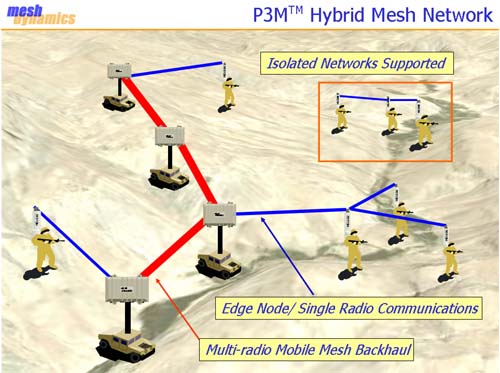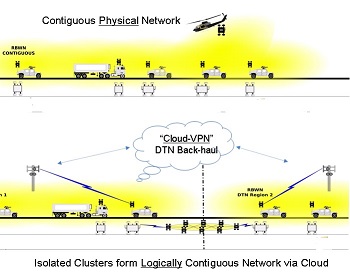Network-Centric Warfare and Wireless Communications
(article reprint on website
www.Meshdynamics.com/documents/MD_MILITARY_MESH.pdf
 Overview
Overview:
Modern warfare is increasingly network centric: Civilian society has moved
from the industrial age focus on automation and scale to an information age
economy based on computing and communications. Warfare is also moving
towards an information age paradigm based on information sharing,
situational awareness, and distributed points of intelligence, command and
control. A widely-networked fighting force is better able to share
information about tactical situations that may be geographically widespread,
asymmetric, and rapidly changing. Commanders must be able to better assess
situations across broad theaters, with extensive data, voice, and especially
video feeds as strategic inputs. Thus, network-centric warfare improves
effectiveness at both the tactical "point of the spear" and in the
achievement of broader strategic goals.
Broadly disseminated knowledge assets enable fighting forces that must
self-synchronize, even as they physically disperse to address dynamic
battlefield conditions. The speed of decision has increased and command
decisions must be rapidly relayed and implemented, to improve battlefield
outcomes. Information superiority has become as important in today's
battlefield as air superiority was in the past in increasing mission
effectiveness.
 Information superiority
Information superiority has become critical as needs of both war
fighters and
commanders have broadened to include real-time video, high-speed data, and
voice. Data and intelligence sources include terrestrial forces and sensors,
satellites, UAVs (Unmanned Aerial Vehicles), and a wide variety of
centralized and distributed information assets.
 Network-centric warfare
Network-centric warfare "cornerstone" technology requirements: The vast
majority of these information assets, command, communications, and control
must be delivered wirelessly, with seamless connections to wired networks
for intelligence resources and other data. Further, these wireless
technologies must support data, voice, and increasingly, video traffic
flows. Beyond those basic capabilities, four key cornerstone capabilities
must be incorporated in the networks designed to support modern warfare:
mobility, high performance support of real-time protocols, distributed
frequency agility, and distributed topologies and network formation.
 Mobility
Mobility: In the network-centric warfare environment, mobility implies
more than just the motion of individuals and vehicles in relation to one
another and to other fixed locations. High performance must be maintained in
motion, which includes rapid reconfiguration of network topology as units
and individuals re-orient themselves in pursuit of battlefield objectives.
To achieve this, networking hand offs between communicating devices must be
coordinated to minimize data outages and/or a reduction in performance while
in motion. These hand-offs must be transparent to communicating units,
maintaining session connectivity while in motion. Location awareness, both
in relation to other communicating devices and space (such as GPS) may also
be key to high performance in motion.
 High performance for real-time protocols
High performance for real-time protocols : With streaming and stored video
an increasingly important part of modern command, communications, and
control, the ability to deliver high bandwidth streams with low latency and
low jitter is critical. This is not just at headquarters command locations,
from a variety of video sensor platforms but increasingly to individual
vehicles and war fighters. In many cases, these video streams must be
delivered expeditiously across multiple hops (node-to-node connections)
without loss of performance. Similarly, voice communications across many
hops and in motion with high performance is a challenge demanding low delay
and jitter at each network device.
 Distributed frequency agility
Distributed frequency agility : The dynamic and unpredictable nature of
modern warfare and the peculiarities of the Radio Frequency (RF) spectrum
environment place a high premium on the capability of individual devices to
independently choose frequencies, locate and connect with peer devices, and
rapidly shift frequencies in an automated, coordinated fashion without
centralized oversight. This capability permits units to be brought on-line
quickly in a hastily-formed network as well as to deal with inadvertent or
malicious interfering and jamming signals in a deployed situation. Ideally,
communicating devices will choose and manage frequencies and channels
independently, for maximum flexibility in responding to mobility or
interfering sources. In addition, these devices should continuously monitor
the RF environment to allow for ongoing automated and coordinated
optimization of the available RF spectrum
.
Robust RF Channel Management
 Distributed topologies and network formation
Distributed topologies and network formation: Relationships between
organizational units, vehicles, and individual war fighters may change
rapidly, bit in terms of command and control and in terms of physical
proximity. In earlier eras, battlefield superiority depended on masses of
contiguous units, but today the focus is on efficiency in achieving mission
objectives. In order to deal with these changing relationships,
communications devices must dynamically monitor and reconfigure network
topologies. With thousands or hundreds of thousands of devices deployed in a
single operation, it would be physically and logically impossible for
network topologies to be defined and managed centrally. Instead, each device
must independently find the best path for interconnection, choosing from
available connections based on rules-based criteria. Topology flexibility
combines with frequency agility to permit networks to form, change, and
reform automatically, without client awareness or intervention.
 The power of distributed dynamic radio intelligence
The power of distributed dynamic radio intelligence: The major challenge in
Third Generation architectural implementations is avoiding co-channel
interference from the multiple radios operating in a given band. This is an
obvious problem when operating in the non-licensed public spectrum, but can
also limit performance in licensed military frequencies used by custom
radios. Earlier Third Generation implementations often restricted this
interference by using directional sectored antennas. But this technique is
useless in the mobile environment.
Meshdynamics' instead allocates channels dynamically, listening for adjacent
nodes as well as competing, interfering, or jamming sources, addressing the
third cornerstone of distributed frequency agility. Channel maps are
selected and reselected as necessary to provide optimum performance and to
maintain connectivity, no matter how the RF environment may change nor how
individual nodes may move in relationship to one another. This would not be
possible with traditional centralized RF channel management through a single
controller, as changes in location and RF environment may isolate sections
of the network from the controller. Instead, a unique Meshdynamics
technology distributes the channel and topology selection to independent but
coordinated functions in each node. This is
Distributed Dynamic Radio
Intelligence. a.k.a
MeshControlTM
The combination of multi-radio Third Generation capabilities and Dynamic
Distributed Radio Intelligence maintain a high degree of connectivity in
motion, ensuring that the Meshdynamics network delivers high performance at
speed. In the military environment, this provides for the maximal utility of
tactical networking, as data, voice and video may be shared no matter the
physical relationship of the communicating units to one another of fixed
bases.
 Hybrid topologies for tactical network extension
Hybrid topologies for tactical network extension: Although the
Third-Generation wireless mesh architecture has been proven to provide much
higher performance than ad hoc First Generation architectures, there are
tactical deployment situations where a combination of the two capabilities
may be useful in achieving the mobility and distributed topologies and
network formation cornerstones. In particular, small footprint (minimal
size, low weight, low power) single-radio peer-to-peer ad hoc nodes carried
by individual personnel may be desired in many tactical situations.
Meshdynamics has pioneered a unique bridging technology between the Third
Generation high performance multi-radio network and widely distributed
individual peer-to-peer ad hoc nodes that allow the individual ad hoc nodes
to join the higher performance network directly when in range, but to hop
peer-to-peer across the ad hoc network if necessary to connect to the Third
Generation high performance network.
In a typical deployment, higher performance multi-radio mesh nodes might be
deployed on supporting vehicles, with body-carried nodes deployed with each
individual. As individuals move farther from the supporting vehicle, their
connection will shift automatically and dynamically between a direct
connection to the vehicle-mounted network and a peer-to-peer bridge when too
distant or obscured from the vehicle.
The Third Generation multi-radio mesh provides bandwidth and low latency for
mission critical voice/video involving wide areas (and consequently many
hops). The ad hoc mesh provides the connectivity to the multi-radio backhaul
and can coexist with it with minimal modification: the ad hoc mesh views the
multi-radio backhaul as an Ethernet link substitute. This extended combined
network is now auto-configurable and scalable under a unified control layer.
Note that the infrastructure mesh supports both “standard” clients – those
that connect to the Access Point but do not have any ad hoc mesh
functionality and “ad hoc mesh” clients.
 Radio-Agnostic Technology
Radio-Agnostic Technology: Meshdynamics' patented and patent-pending Third
Generation implementation is not limited to any particular number of
physical radios, or indeed to the concept of separate physical radios at
all. Instead, the Meshdynamics networking algorithm treats multiple physical
and/or logical radios as a pool of available connections to be dynamically
managed for optimum performance in a mobile environment. Meshdynamics'
powerful networking algorithms have been designed to work over a variety of
civilian and military radio bands. Current production products serve Wi-Fi 802.11 a/b/g at 2.4 and 5.8 GHz and public safety nets at 4.9 GHz. Support
for 900 MHz, 700 MHz, and WiMAX bands is in development. Custom development
capabilities are also available for military radios operating in a broad
range of bands.
 Location and relationship capabilities
Location and relationship capabilities: Because of the efficient, yet
extensible, node-to-node management information path provided by the
Meshdynamics network, additional functionality is available for monitoring
and reporting of location information in support of the mobility cornerstone
technology requirement. Individual nodes may be fitted with GPS (Global
Positioning System) receivers and real-time information on the nodes'
locations (fixed or in motion) may be provided to administrators or to other
applications using standard data protocols.
In addition, each node maintains a listing of the MAC IDs of every
associated user device. This information may be interpolated by an external
application to indicate with which nodes individual client devices are
currently associated. Combined with the known fixed or GPS-derived location
of each node, this provides a rough approximation of end user location and
distribution.
 Channel and topology agility in military environments
Channel and topology agility in military environments: In order for the
Meshdynamics network to continually and dynamically respond to a changing
tactical environment, each node is designed to periodically and momentarily
"listen" to its surroundings. This brief activity does not appreciably
diminish data capability, but allows each node to constantly be aware of a
changing environment. In hastily-formed networks, newly deployed units can
rapidly discover (and be discovered by) adjacent units already operational
in the network. No site survey or channel pre-configuration is necessary:
the distributed dynamic radio intelligence in each node manages the complete
network set-up process.
This capability is provided by a constant exchange of an informational
heartbeat between nodes. This efficient datagram delivers information about
adjacencies to permit each individual node to make independent but
coordinated decisions regarding channels and topologies. In high-speed
mobility environments, an additional dedicated "scanning" radio may be
incorporated into each node to provide the smoothest and most rapid
adaptations of channel and topology for near instantaneous node-to-node
switchover as required. A recent successful trial involved transmission of
real-time video from a moving vehicle connecting through a series of
roadside fixed nodes. Video transmission was maintained without dropouts, as
the dedicated scanning radio allowed the mobile node to continually connect
in turn to the best fixed node. Network start-up is automatic and immediate
when power is applied to the nodes. Meshdynamics units are compact and
rugged, making for minimal transport cost and weight in hastily-formed and
mobile applications.

